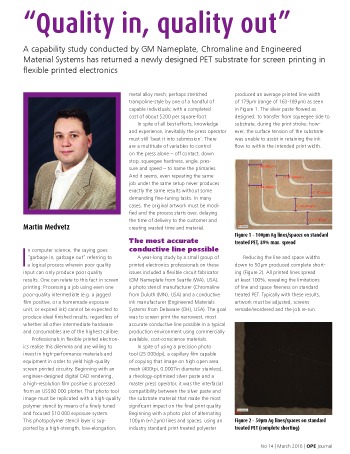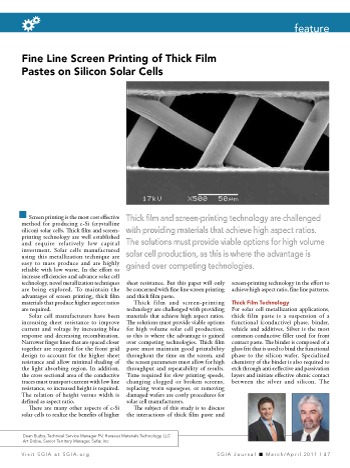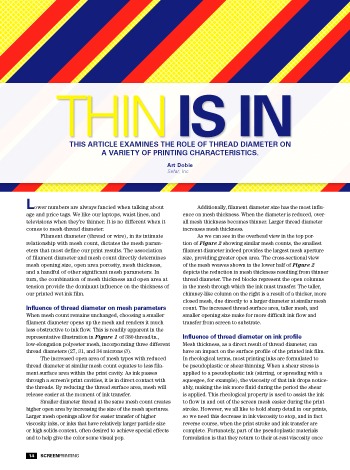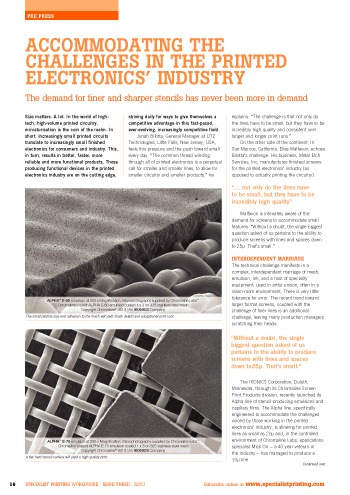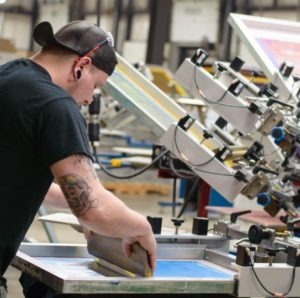
Mick’s Technical Tips

Looking for insight on the wonderful world of screen making? Consult the writings Mick Orr. Mick has over 35 years of experience in the screen printing industry. In his 35+ years of experience, Mick Orr was Chromaline’s Technical Sales Representative for Canada. In addition, he was also Chromaline’s Technical Guru and Applications Training Specialist. His knowledge spans a wide range of applications including membrane switches, textiles, specialty graphics, and faceplates.
- Essential Tools for Screen Printers
- Basic Training, Parts I, II, & III
- Choosing an Emulsion System
- Testing Exposure Equipment
- Proper Exposure
- Comparing Exposure Units
- Determining Proper Exposure
- How to use an Exposure Calculator
- Swell Testing Capillary Films
- Applying Capillary Film
- Develop Pinholes on Press
- Effects of Underexposed Screen
- How to Dry a Screen
- Humidity Problems & Solutions
- Viscosity & Solids Misconceptions
- Quality: The Winning Run
- Coating Consumption
- Working with MAX-R Products
- Introduction to PHAT Film
Journal of Microelectronics and Electronic Packaging: Fine Line Printing for Printed Electronics
A major obstacle in screen printing conductive low-temperature curing polymer thick-film (PTF) pastes onto common flexible PET substrate materials is the substantial spread of the pastes beyond the designed line width after printing. Industry observation and controlled testing have shown this spread can be as much as 80% over the circuit design’s intended line width. This phenomenon prevents designers from increasing circuit density and/or reducing circuit real estate without incorporating other more involved and higher cost patterning methods. This article by Art Dobie, Chromaline’s Northeast Sales Rep, provides results of numerous in-house and field testings, comparing printed line width control, edge definition, and improved conductivity of printed polymer Ag conductors on different flexible PET substrates.
The Journal of Microelectronics and Electronic Packaging is published quarterly by the International Microelectronics Assembly and Packaging Society (IMAPS). This archival Journal is dedicated to publishing peer-reviewed papers in microelectronics, multichip module technologies, electronic packaging, electronic materials, surface mount and other related technologies, interconnections, RF and microwaves, wireless communications, manufacturing, design, test, and reliability.
Printwear Magazine: Make A Better Screen
There are YouTube videos, user guides, and a lot of guesswork on how to make a screen. Some of the information out there is very informative, while others, not so much. When it comes down to it though, it’s not just about making a screen, but making a better screen, and possibly even a great screen.
This article by Mick Orr, published in Printwear Magazine, covers everything you need to know about making a better screen for screen printing, including:
- Initial Considerations
- Coating and Emulsion
- Exposure
- And more
Printwear is the leading source for news and education on direct-to-garment, heat transfers, screen printing, embroidery, and sublimation.
Magazine for Organic and Printed Electronics: Quality In, Quality Out
Check out this capability study conducted by Martin Medvetz, Chromaline’s Domestic Sales Manager in which he discusses a newly designed PET substrate for screen printing in flexible printed electronics.
In computer science, the saying goes “garbage in, garbage out” referring to a logical process wherein poor quality input can only produce poor quality results. One can relate to this fact in screen printing: Processing a job using even one poor-quality intermediate (e.g. a jagged film positive, or a homemade exposure unit, or expired ink) cannot be expected to produce ideal finished results; regardless of whether all other intermediate hardware and consumables are of the highest calibre.
Professionals in flexible printed electronics realize this dilemma and are willing to invest in high-performance materials and equipment in order to yield high-quality screen printed circuitry.
The Magazine for Organic & Printed Electronics, now called OPE Journal, is a globally circulated magazine for the organic and printed electronics industry.
SGIA Journal: Fine Line Screen Printing of Thick Film Pastes on Silicon Solar Cells
Thick film and screen-printing technology are challenged with providing materials that achieve high aspect ratios. The solutions must provide viable options for high volume solar cell production, as this is where the advantage is gained over competing technologies.
Screen printing is the most cost effective method for producing c-Si (crystalline silicon) solar cells. Thick film and screen printing technology are well established and require relatively low capital investment. Solar cells manufactured using this metallization technique are easy to mass produce and are highly reliable with low waste. In the effort to increase efficiencies and advance solar cell technology, novel metallization techniques are being explored. To maintain the advantages of screen printing, thick film materials that produce higher aspect ratios are required.
The SGIA Journal delivers insights and information from industry experts on topics including best practices, market trends, sales and marketing, and printing techniques and applications.
Manufacturing the Solar Future: Metallization Pastes on Crystalline Silicon Solar Cells
A common goal for screen-printable front-contact metallization pastes is to achieve thin and tall gridlines with high aspect ratios, which provide a decrease in grid resistance as well as an increase in short-circuit current via minimizing cell shading. There are, however, several limiting factors that exist in obtaining a high aspect ratio, a key one being screen design.
The purpose of this paper, in which Art Dobie from Chromaline was a contributor, is to examine commercially available screen designs (i.e. different mesh, emulsion over mesh (EOM) thickness and emulsion composition) in order to determine the optimal screen design for processing SOL9411, a commercially available Heraeus high aspect ratio front-contact metallization.
Manufacturing the Solar Future 2012, the second in the Photovoltaics International PV Production Annual series, delivers in-depth technical manufacturing information on PV production processes. This volume compiles 44 up-to-date technical articles written by over 100 leading PV industry experts from the pages of the Photovoltaics International quarterly journal. Covering everything from Site Selection to Emitter Formation and Tabbing & Stringing techniques, this book is an indispensable compendium of information for anyone seeking to expand their knowledge of photovoltaics manufacturing.
Screen Printing Magazine: Thin Is In
Filament diameter (thread or wire), in its intimate relationship with mesh count, dictates the mesh parameters that most define our print results. The association of filament diameter and mesh count directly determines mesh opening size, open area porosity, mesh thickness, and a handful of other significant mesh parameters. In turn, the combination of mesh thickness and open area at tension provide the dominant influence on the thickness of our printed wet ink film.
In this article, Art Dobie examines the role of thread diameter on a variety of printing characteristics.
Screen Printing Magazine is the leading publication and trusted source of information for the screen printing industry. Every issue of the magazine covers news, products, features, and information about the latest methods, equipment, and materials. Topics also include alternative imaging processes, color management, prepress, ink developments, finishing technology, cutting-edge applications, and more.
Specialist Printing Worldwide: Challenges in the Printed Electronics Industry
The demand for finer and sharper stencils has never been more in demand in the Printed Electronics Industry. This article talks about the challenges and how to accommodate them.
Size matters. A lot. In the world of high-tech, high-volume printed circuitry, miniaturization is the coin of the realm. In short, increasingly small printed circuits translate to increasingly small finished electronics for consumers and industry.
The Alpha line of stencil-producing emulsions and capillary films by Chromaline is specifically engineered to accommodate the challenges voiced by those working in the printed electronics’ industry, is allowing for printed lines as small as 20µ and, in the controlled environment of Chromaline Labs by specialist Mick Orr – a 40 year veteran in the industry – has managed to produce a 10µ line.
Specialist Printing Worldwide is the leading quarterly technical reference source for users of screen and wide format digital printing systems with technical content covering digital, pad and screen printing for the industrial, graphic and textile sectors across all continents.



